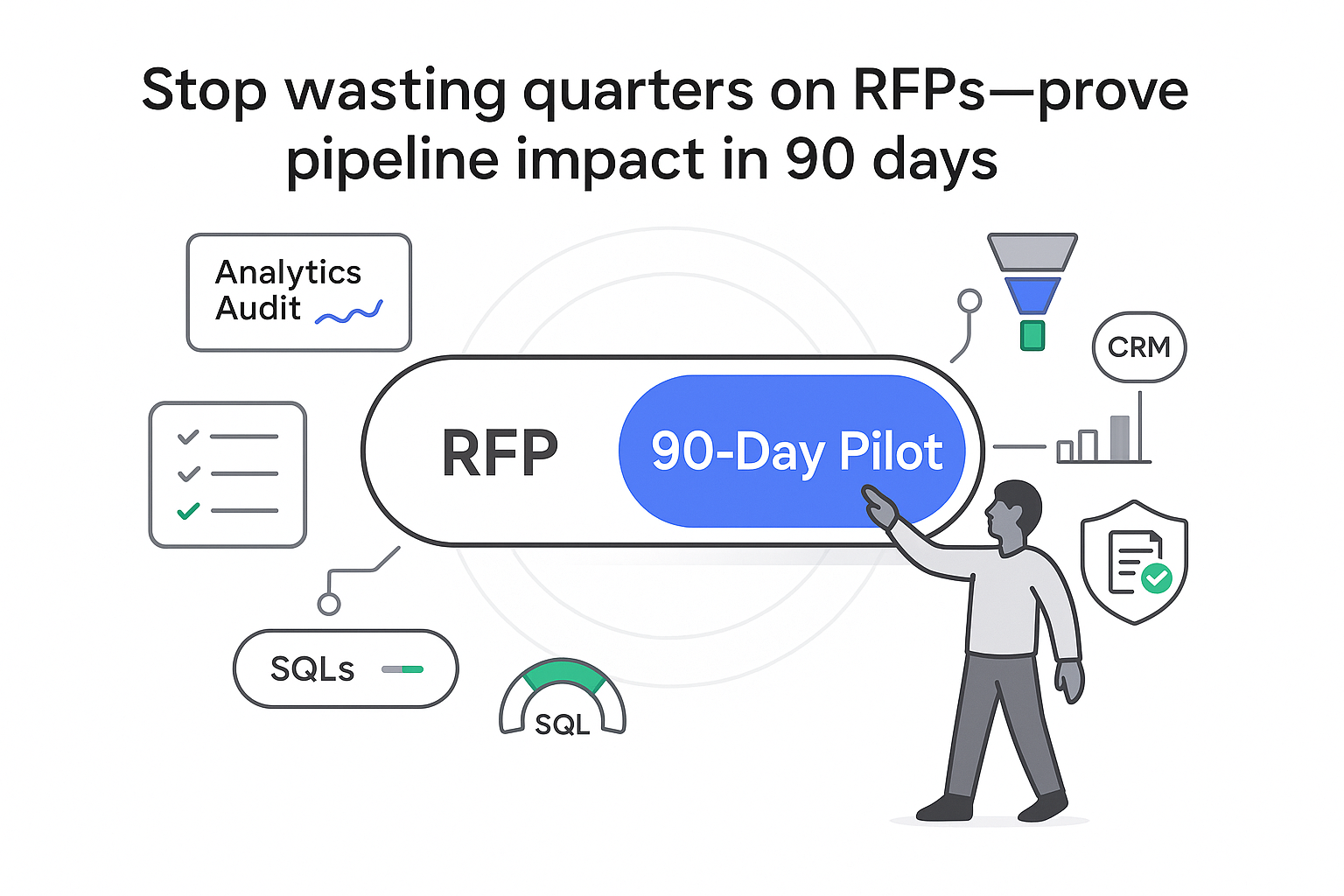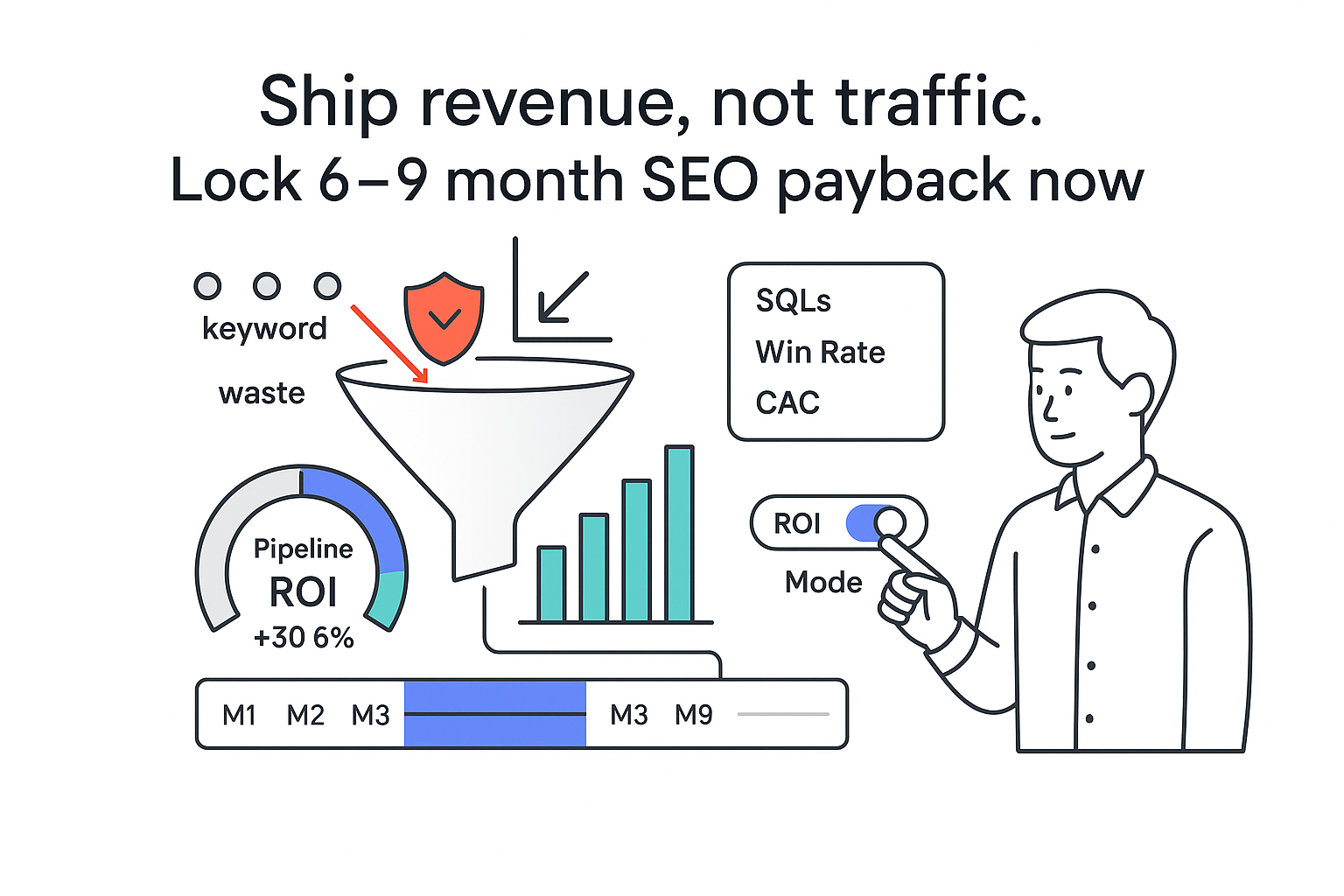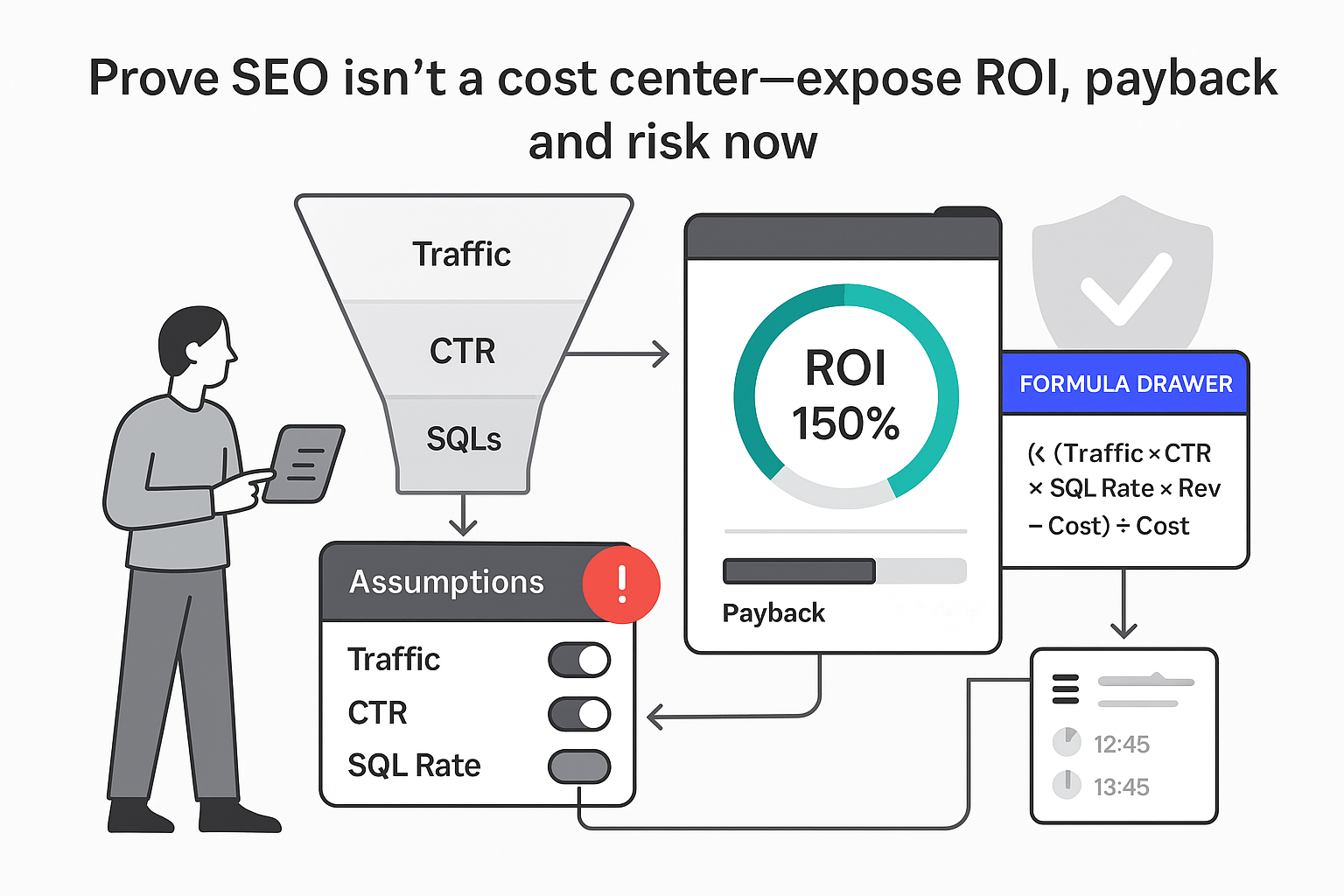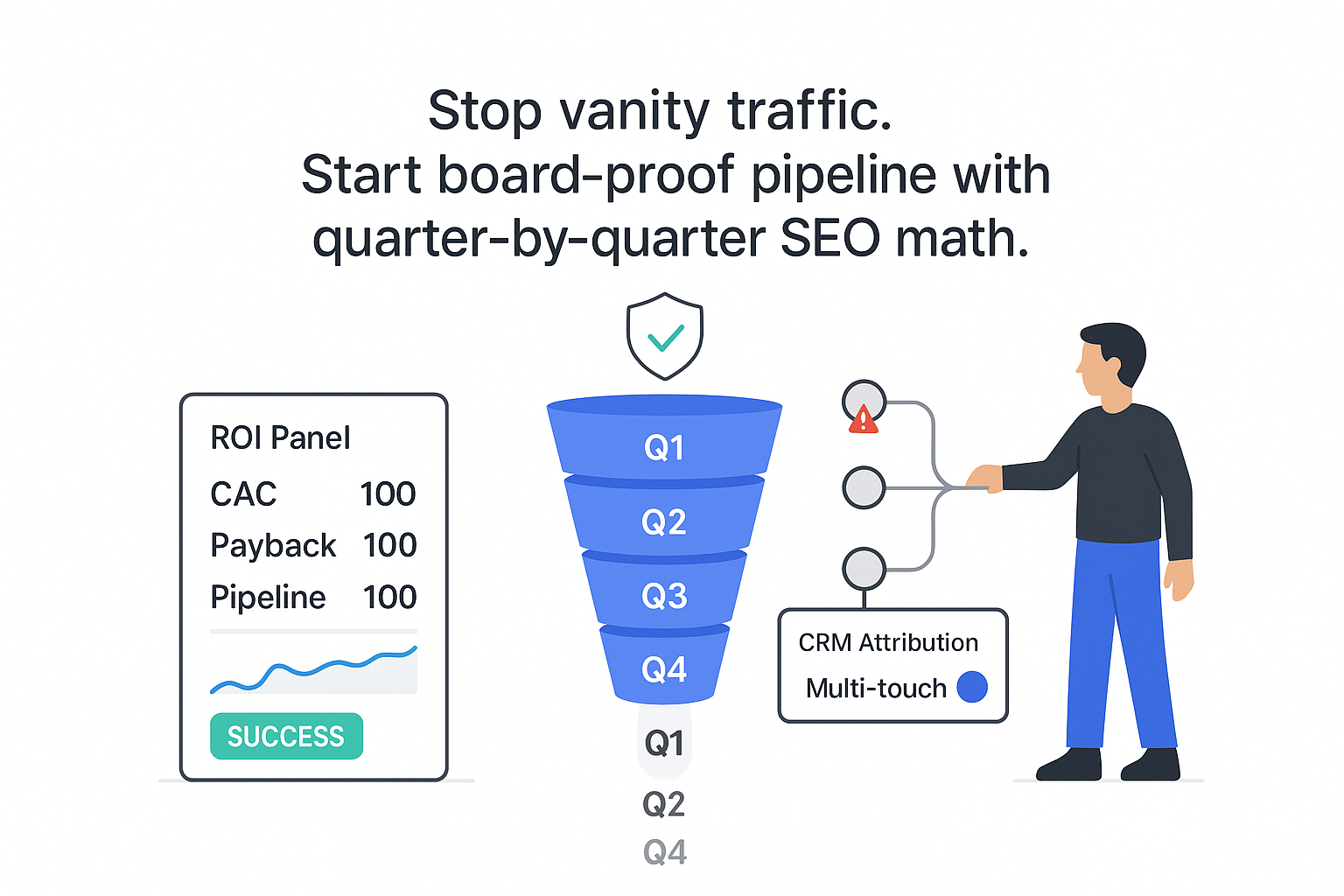I do not need another glossy deck to pick the right partner. I need a plain, working plan that predicts outcomes and protects my budget. When I sit as a CEO or founder weighing a B2B SEO agency, I think less about feature lists and more about how fast the work shows up in pipeline. That is the thread that runs through everything below.
The SEO RFP dilemma for a B2B SEO agency
RFPs promise certainty. Yet they rarely predict performance. I can read answers for weeks, rank spreadsheets, and still end up guessing. The people look sharp. The slideware is slick. Then month five hits and my calendar is packed with status updates while sales asks where the leads went.
An RFP is not bad. It is just incomplete without context. The smarter move is outcome first: what business result must happen, by when, with what constraints. Then I choose the path that gets me there with the least ceremony. For more on why traditional selection often fails, see the MarTech Replacement Survey and 10 steps to making better vendor selection choices.
Quick diagnostic to choose RFP or pilot
- Budget: Can I fund a small pilot without starving paid or sales enablement
- Timeline: Do I need signal in 60-90 days or can I wait two quarters
- ICP: Is my ideal customer profile documented and aligned with sales
- Sales cycle: Is time to close short enough to see movement this quarter, or will pipeline value be the main proof
- CRM readiness: Is Salesforce or HubSpot clean enough to track sourced and influenced opportunities
If most answers lean yes, I fast-track a pilot. If several lean no, a more formal RFP helps me slow down and clarify needs before I spend. Either way, I keep the RFP light and focused on use cases. I ask for one or two scenarios that tie to revenue - rank for comparison queries in one priority segment, or improve demo conversion on a high intent page. I require a short plan and a small build, not a long essay.
Simple RACI for stakeholder clarity
- Responsible: SEO lead or growth manager who drives the work
- Accountable: Head of marketing who owns the target and budget
- Consulted: Sales leader for ICP nuance, RevOps for tracking, Product or Service lead for messaging
- Informed: CEO, finance, IT and security, legal and procurement
Two-way discovery with my SEO vendor
The right B2B SEO agency should prove they understand my market before they touch my site map. I want a discovery that feels like a deal review, not a generic checklist. I also surface hidden assumptions early - like how much of my CRM data I actually trust - so we avoid rosy forecasts built on messy inputs.
I require my SEO vendor to cover
- ICP and deal sizes: Who buys, average contract value, decision group
- Sales stages and win or loss reasons: Where deals stall, why I win, why I lose
- Content gaps and SERP landscape: What ranks on page one, who owns comparisons, what shows in People Also Ask, news, video, and map packs
- Compliance and risk: Industry rules, restricted claims, privacy obligations
I use a simple discovery script
- Which services or packages deliver the highest margin right now
- Which segments close faster and retain better
- Which keywords carry buying intent based on past wins, not just search volume
- What content my sales team shares during late stage calls
- What conversion events map to SQL and opportunity creation
- Which integrations must be honored, including GA4, GSC, CRM, and marketing automation
Governance matters too. I borrow from AI and content governance
- Policies on AI usage in content creation, human review steps, and model disclosures
- Link acquisition standards, disallow lists, and conflict-of-interest disclosures
- Editorial standards, fact checking, and brand voice guardrails
- Customer data handling, access controls, and incident reporting flows
For broader standards context, global bodies such as IEEE publish AI governance guidance that can inform your policy set.
Red flags I watch for
- Vague answers about how they will win links in my space
- No documentation around AI-assisted writing or editing
- Generic content calendars that ignore sales input
- Promises of quick rankings with no mention of technical constraints
Live SEO audit vs canned demos
Slide decks are easy. Progress is not. I replace the pitch with a live audit on my data using GA4, Google Search Console, and CRM (read-only access works). I ask for a readout I can replay and share with sales.
Scope for a useful audit
- Technical: 10-15 issues that genuinely slow crawl or indexing
- Content opportunity map: bottom-funnel pages and comparison queries
- Link risk sample: toxic patterns and a cleanup plan
- Demand gap analysis: tie search intent to pipeline potential
I demand evidence for every claim
- Before/after examples from similar motions, e.g., moving from listing keywords to ranking for high-intent comparisons
- Cohort analyses tied to page groups, not vanity metrics
- SERP volatility overlay to explain swings, plus what stabilizes a page
- Accounting for confounders like seasonality, promos, and major releases
I capture the audit on one page
- Summary of key issues by business impact
- Three recommended plays with effort, time to signal, and owner
- Tracking plan in GA4 and CRM to show sourced and influenced pipeline
- Risks and dependencies my team must accept or fix
I also ask for a short recorded walkthrough of the audit. If they cannot explain it simply, my team will not execute it quickly.
SEO proof of concept
Instead of a long RFP, I run a 60-90 day proof of concept with a narrow scope tied to one or two revenue-driving plays. I baseline metrics two to four weeks prior and, when possible, hold back a similar set of pages as a control.
Good starting plays
- Bottom-funnel content for priority services, built from sales objections and competitor comparisons
- Programmatic pages for repeatable service templates, with quality controls
- Intent-led optimization of existing pages that already rank on page two or three
I define success upfront
- SQLs and pipeline value from organic
- Demo bookings or consultation requests
- Opportunity creation rate for traffic that lands on target pages
I spell out SLAs and owners
- Content delivery dates with named reviewers
- Technical fixes with an engineering owner and release schedule
- Link review queue with sources, anchor text, and acceptance rules
- Weekly analytics snapshots tied to CRM fields (and a shared glossary)
Risk controls I insist on
- Content QA for claims and compliance
- Link review by my team before outreach
- Staging checks for key templates before release
Acceptance criteria with a simple go/no-go
- Did the pilot hit the agreed leading indicators by week six
- Are SQLs rising in the named segments
- Did opportunity value move in CRM as tagged
- Are costs aligned to scope with no surprise add-ons
If yes, I scale the scope. If no, I exit cleanly with the work product owned by my company.
SEO pricing and comparisons
Comparing proposals can feel like comparing apples to fruit salad. I standardize the format so I can see the real cost and the implied trade-offs. For negotiating with vendors, this perspective helps: 6 things martech vendors don’t want you to know.
I ask every B2B SEO agency to quote in this structure
- Pilot fee with clear deliverables and time box
- Monthly retainer and what it includes
- Variable costs for content, links, and developer time
- Tool stack that will be used
- Hidden costs I should expect: approvals, internal time, migrations
I build a total cost of ownership model versus paid media
- Include expected ramp for organic and expected decay for paid when budgets shift
- Model CAC payback with conservative organic uplifts and a sensitivity range for Google updates and SERP design changes
- Include my team’s hours as an internal cost so the math reflects reality
I also require transparent discount logic tied to term and scope. No mystery bundles. No fast-expiring offers. If a lower price depends on longer terms, opt-out rights must be strong. For thinking beyond category labels and suites vs specialists, see Big players vs. niche specialists: Choosing your martech vendors.
Good, better, best example scopes for apples-to-apples
- Good: one market, one service line, three priority pages, two technical sprints
- Better: two markets, two service lines, six priority pages, three technical sprints, light digital PR
- Best: three markets, full service mix, twelve priority pages, ongoing technical work, digital PR, and enablement for my team
SEO contract risks and exit plan
Contracts should reduce stress, not add it. I protect my company with clear terms that match how SEO really works.
Key protections I include
- Opt-out or termination for non-performance tied to agreed leading indicators and quality standards
- IP ownership of all content, designs, and data my fees funded
- Non-poach language that covers my team and the agency team
- Link liability and a content takedown SLA for anything risky
- Reasonable notice periods; no auto-renew traps
Privacy and security guardrails
- Data processing agreements that match my industry needs
- References to relevant certifications if applicable
- PII handling rules and anonymization standards
- Access controls for GA4, GSC, and CRM with least privilege
- Confidentiality terms that survive termination
Incident reporting for tough days
- Define incidents like a sharp traffic drop, deindexing, or negative SEO
- Set response times, escalation paths, and required communications
- Require a written post-incident review with actions and owners
Onboarding and offboarding checklists
- Onboarding: access list, brand and editorial guides, ICP notes, compliance rules, tracking plan, weekly cadence
- Offboarding: revoke access, export content and data, document redirects and technical changes, final performance readout
Measuring SEO KPIs at renewal
I measure what matters from day one, not month eleven. My future self thanks me when renewal time hits. I also make assumptions explicit - seasonality, sales capacity, major site changes - so forecast vs actuals is a fair comparison.
I set the scoreboard now
- Leading indicators: crawl health, indexation, impressions, content velocity, technical fixes completed
- Core indicators: rank share for priority terms, non-brand clicks, SQLs, stage progression
- Lagging indicators: pipeline value, revenue, CAC payback, LTV:CAC
I require monthly executive summaries
- Clear wins and misses, not a dump of charts
- QA notes for content and technical work
- Attribution clarity, both last-touch and modeled with CRM tie-backs
I keep a renewal decision rubric
- Did we hit the agreed leading and core indicators on schedule
- Did organic sourced or influenced pipeline cover fees by a reasonable multiple
- Is quality consistent and risk managed
- Are we faster and clearer now than quarter one
I use a one-page forecast-versus-actuals view my CFO can read in two minutes. I show trends, not one-time spikes, and marry GA4 data with CRM reality.
SEO strategy
This is where many teams speed past the basics. That is a mistake I can fix in a week with focused work. My B2B SEO agency should push for this clarity and help me build it. For a capability-first lens, see Beyond quadrants: An alternative approach to martech selection and Martech stacks evolve through capabilities, not tools.
Directional strategy
- Markets and ICPs: the segments I will pursue this year, including size, pain, and buying committee roles
- Priority services: which services matter most for margin and growth, ranked
- Positioning: how I am different in words my buyers use; sales input is gold
- Plays to test: two to three growth plays like comparison pages, industry templates, or partner pages
Requirements and rationale
I work backward from outcomes and rank needs by impact on pipeline and time to signal.
- Must-haves: clean technical base, content production sales trusts, link acquisition that passes a sniff test, tracking tied to CRM
- Nice-to-haves: industry PR, video for SERP variety, experimentation tools
- Constraints: tech stack limits, legal review cycles, design bandwidth, translation if I sell in multiple regions
Simple prioritization matrix
- Impact high, effort low: green
- Impact high, effort high: yellow
- Impact low, effort low: blue
- Impact low, effort high: later
Example roadmap across two quarters
- Month 1: discovery, audit, tracking plan, three bottom-funnel pages scoped and drafted, two technical fixes shipped
- Month 2: two comparison pages shipped, internal linking patterns improved, begin digital PR for one service area
- Month 3: programmatic template live for service variations, add schema, first cohort analysis readout
- Month 4: expand comparison coverage, double down on pages with early traction, refine conversion copy on high-intent pages
- Month 5: second technical sprint, new case studies linked from key pages, continue PR
- Month 6: renewal readout prep with forecast vs actuals, next wave of pages planned
Across this work, I keep a short weekly note that says what shipped, what slipped, and why. It sounds basic. It prevents surprises.
A few trend notes I thread into my plan
- Google keeps rolling out AI-driven features that change click patterns. I expect some volatility and design for it with stronger titles, clearer meta descriptions, and smarter page layouts.
- Privacy rules keep tightening. I capture first-party signals cleanly and pass them to CRM. The B2B SEO agency I pick must be comfortable with consent and data hygiene.
- Quality editorial wins over fluff. AI assistants can help with speed. Humans must guide structure, facts, and tone.
One last thought. When I evaluate any B2B SEO agency, I ask myself a plain question: Do I know exactly what they will do in the first 30 days, who will do it, how I will see progress, and what we will stop doing if we miss a gate. If the answer is yes, I am on the right track.







.svg)